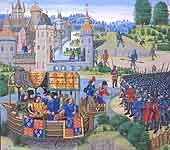|
Places to visit | Background information | Find a book about it |
|
|
Hundred Years' War 1337-1453 |
|
|
1337-1360
English
victories |
|
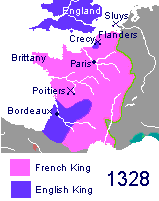 MAP 1: Who ruled where in 1328: English King Edward III held lands mainly in Aquiraine, the rich wine-growing province around Bordeaux in SW France. |
Fighting started in the Hundred Years' War because the Kings of England - descendants of William the Conqueror who still spoke French -wanted to rule France as well. France was temptingly weak and divided. It began with the English King already ruling a large part of France (see Map 1); it ended with him ruling hardly any, but with what is now Nord - Pas de Calais split off under foreign rule for several centuries. The English claim The French split The first faction rushed to crown a French cousin whose claim. was not as good as Edward's. With their new king, they attacked Edward's lands in SW France (Aquitaine) and in 1337, Edward III declared war. The other faction allied with Edward. Counts of Flanders tended to take England's side against France in any conflict, because of links with England in the vital wool trade. Powerful lords in other outlying regions such as Brittanny and Normandy feared the ambitions of those who wanted a stronger centralised French kingdom. They allied with the English. to help keep their independence |
|
The English
"nutcracker" |
|
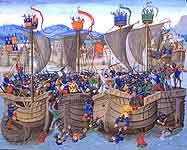 English win one of the first ever sea battles: the Battle of Sluys 1340 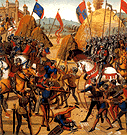 English slaughter French knights at the Battle of Crecy 1346 |
French disasters: Edward III now controlled the Channel and was free to invade and wage war over the enemy's lands - which proved catstrophic for the people of the North. The English army was a mixed force of infantry, archers, pikemen and light cavalry - battle-hardened after successfully fighting the Welsh and Scots, and made up of well-trained and organised English mercenaries, enthusiastic supporters of his cause and eager for plunder. They proved to be the most effective army Europe had seen since the Romans. (2) losing their finest
knights at Crecy As the heavily armoured French knights struggled up the muddy hillside in a traditional feudal cavalry charge. they were massacred by the English infantry and archers - a lesson they did not learn. |
|
(3) losing Calais, which
gave England a base in N.France His queen took pity on them, and asked if the brave burghers could also be spared if the town surrendered. The citizens of Calais were permitted to leave their town without further bloodshed; their homes were given to new English settlers, who made Calais into a fortified English stronghold - a base for military expeditions into France and the near-Continent for the next two centuries. |
|
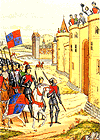 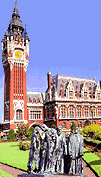 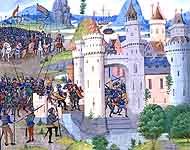 The capture of Calais (L to R): 1. Edward III besieges the town in 1347 2. Calais Town Hall with its spectacular belfry, and the famous statue of the Six Burghers by Rodin. 3. In 1349, the French tried to retake Calais - despite sickness, the English defenders beat them off. |
|
|
Misery and the Black Death |
|
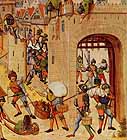 Soldiers looting a captured town |
The first half of the Hundred Years War proved as catastrophic for the North as well as the rest of France. Destructive fighting disrupted the economy: there were appalling plagues (at least a third of the population of both England and France died in 1348 in the Black Death), and violent and bloody revolts in which peasants looted nobles' houses and castles. French defeat and
creation of the Franc |
|
* Francs became the official national money of France at the French Revolution 1789, until the euro (2002). |
|
|
Reverses
for the English The dying English king Edward III had hoped to strengthen the Anglo-Flemish alliance by marrying the sought-after heiress to his fifth son - instead his ally was now controlled by France. As the English grew weaker, Philippe brought the whole area of Falnders firmly under his control. It remained Burgundian for four reigns of French kings. |
|
|
|
English Peasants Revolt
1381 The French took advantage of English weakness. Having driven the English out of all but Calais and a few other strongholds in France (see Map 2), the French struck across the Channel, helped by Spanish warships based in Rouen. Savage French raids ...then Burgundy splits
with the French crown In 1407 the French royal family divided into two camps - the Armagnacs (Maison d'Orleans) and the Burgundians. Their feud plunged France into civil war. The powerful Duke of Burgundy failed to win the French crown, but decided to set up his own empire instead. |
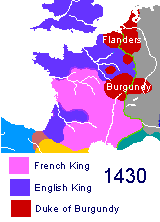 MAP 3: 1430 - the height of English power in France. The Duke of Burgundy, allied with the English has captured Joan of Arc. |
1415 Azincourt - the
height of English power After this victory, Henry V conquered the north and west of France (see Map 3) - very nearly succeeding in achieving his grandfather Edward III's ambitions. Burgundy expands in the
North... ...and Henry V prepares
his coronation in Paris |
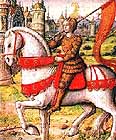 Jeanne d'Arc - a peasant girl inspired by "voices of angels" rouses the demoralised french trrops and saves Orléans from an English siege |
Joan of
Arc - the French fight back But Joan was captured by Burgundian troops and handed over to the English. They burnt her as a witch (for wearing men's clothes), at English-held Rouen in 1431. English Henry VI was crowned king of France in Paris. However Joan had inspired a French revival.With a
well-organised disciplined army, the French king Charles VII
now had the war-weary English on the run. |
|
In 1435 Charles VII bribed Philippe le Bon, Duke of Burgundy, to break the alliance with the English in exchange for Ponthieu. Only fours years later, though, he re-established the important wool trade relations with England and the Flemish economy took off again. |
|
|
Driving the English out of France |
|
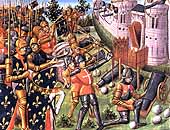 1450 - French king captures Cherbourg, England's last stronghold in Normandy - ending the link from 1066 |
One by one, Charles VII besieged and captured the remaining English strongholds. With the capture of Bordeaux (1453), the English had lost all their French all their French lands except Calais.(see Map 4) That was really the end of the One Hundred Years war so far as England was concerned , though a formal treaty to end the war between England and France was only signed in 1475. Charles VII's son, Louis XI (1461-1483) now fought to assert his power over the mighty nobles - especially the Duke of Burgundy.... |
|
The Aftermath: France v. Burgundy |
|
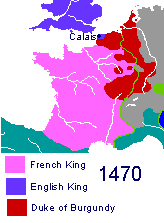 MAP 4: By 1470, the English have lost everything except Calais; Henry XI turns all his forces on the Duke of Burgundy... |
In 1461 Louis XI confronted Charles the Foolhardy, the last duke of Burgundy, who ruled a huge and very rich state stretching from the North Sea to the Alps (see Map 4) The frontier lands between them, Artois and Picardy, were ravaged once again by bitter fighting. |
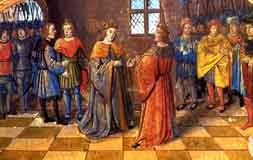 1464: young French King Louis XI (centre, left) fails to agree peace terms with Charles, Duke of Burgundy (centre, right). They fight for the next 13 years. |
|
|
How Nord-Pas de Calais
came under foreign rule Before the dead Duke's inheritance had completely fallen to Louis XI, Marie, his heir and the new Duchess of Burgundy, married a Hapsburg, the future Emperor, Maximilian of Austria. It took Maximilian 20 years to re-establish control over the lands of his predecessor. Louis XI continued fighting on this distant frontier, reluctant to leave the North in foreign hands. But by 1493, Maximilian as Duke of Burgundy once again ruled Arras and the Artois region as well Flanders. Fpr the next 150 years, France fought to keep hold of the region around Montreuil and Boulogne. Four isolated French strongholds also remained in Burgundian territory , including Therouanne and Hesdin. |
|
|
France fought to control Montreuil and the Artois region |
|
|
|
Maximilian's grandson, Charles V, became Emperor in 1519. To limit his territorial ambitions and to get help in regaining Artois, François I sought an alliance with England. In 1520 they met at the Field of the Cloth of Gold , but failed to agree. Henry VIII went off to Gravelines to join forces with Charles V instead. 1529 - the Treaty of Madrid-Cambrai restored the Artois region to the Charles V as Duke of Burgundy. For a century, Montreuil became the frontier fortress of France. 1537 - Charles V besieged and captured Montreuil with English help. they pillaged and largely destroyed the town. 1544 - Henry VIII besieged and captured Boulogne, but handed it back to France in 1550 for a considerable sum. Montreuil held out against another Anglo-Spanish siege. |
|
1553 - The French continued their bloody incursions into Imperial territory from their Artois strongholds. An infuriated Charles V ordered their total annihilation: Thérouanne and Hesdin were razed to the ground and the soil rendered sterile with salt. 1558 - The French finally won Calais back from the English. In the 16th century, and until reconquest by the French, blood origins remain of vital importance : under Spanish rule, you were only allowed to work for the local administration if you were born in Flanders, Artois or Hesdin. 1567 - Meanwhile, the French king built a strong Citadelle at Montreuil. It was again attacked by the Spanish in 1594 - they realised the gateway was a weak point, so the town walls were strengthened with only two gateways in and out. In 1604, Henri IV visited Montreuil and declared it "Fidelissima Picardorum Natio." 1659 - Louis XIV's Treaty of the Pyrénées rejoined the Artois region to France, leaving Montreuil safely well behind the frontier. |
|
|
||||
|
Places to
visit: |
||||
|
Related background
information |
|
|
1337-1453 |
|
|

